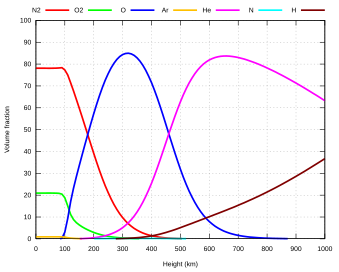The heterosphere is the layer of an atmosphere where the gases are separated out by molecular diffusion with increasing altitude such that lighter species become more abundant relative to heavier species. The heavier molecules and atoms tend to be present in the lower layers of the heterosphere while the lighter ones are present higher up. The exact boundaries between the different molecules vary according to temperature and solar activity.[1] The heterosphere extends from the turbopause to the edge of a planet's atmosphere and lies directly above the homosphere.[2]
Earth's heterosphere

The Earth's heterosphere begins at about 100 km altitude and extends to the outer reaches of its atmosphere.[3] It incorporates most of the thermosphere and all of the exosphere. The major constituents of Earth's heterosphere are nitrogen, oxygen, helium, and hydrogen. Nitrogen and oxygen compose the lower portion of the heterosphere. In the higher levels of the heterosphere, above about 1,000 km, helium and hydrogen are the dominant species present.[3] The heterosphere also incorporates the ionosphere with ions present in the heterosphere's lower levels. These include O+, NO+, O2+, and N2+.[2] Due to the diffused nature of the heterosphere's gases, its density at any given height is not entirely dependent on the temperature. Other factors contributing to density variations in the heterosphere include day and night cycles, solar activity, geomagnetic activity, and seasonal cycles.[4] The heterosphere contains less than 0.001% of the Earth's atmosphere's total mass.[5]
References
- ^ "The Thermosphere: A Part of the Heterosphere" (PDF).
- ^ a b "OS411B: M2, U1, P4 : The Heterosphere". www.shodor.org. Retrieved 2019-05-30.
- ^ a b "Atmosphere | gaseous envelope". Encyclopedia Britannica. Retrieved 2019-05-30.
- ^ "1965SAOSR.184.....J Page 2". articles.adsabs.harvard.edu. Bibcode:1965SAOSR.184.....J. Retrieved 2019-05-30.
- ^ "ATMOSPHERIC COMPOSITION TEMPERATURE AND FUNCTION". web.ccsu.edu. Retrieved 2019-05-30.
